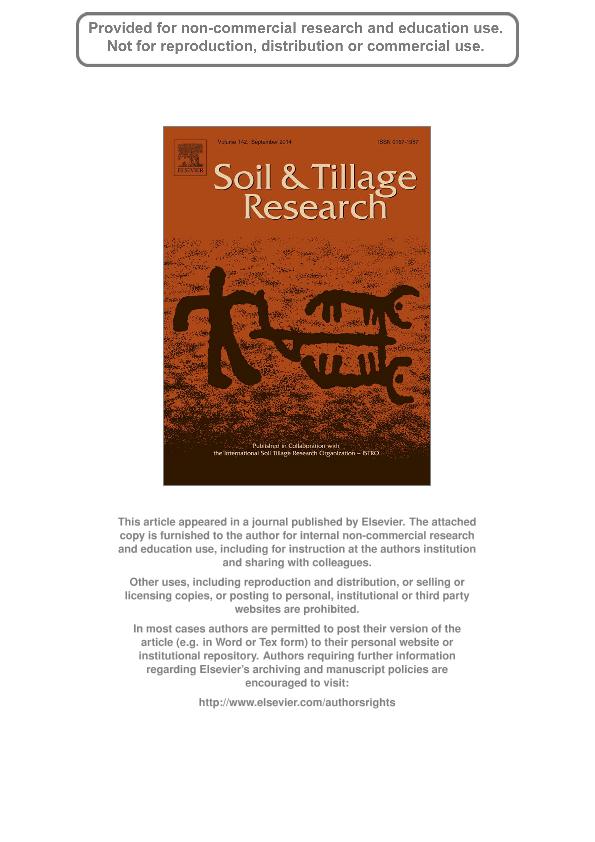Artículo
Effect of conventional and no-till practices on solute transport in long term field trials
Okada, Elena ; Costa, Jose Luis; Bedmar, Francisco; Barbagelata, Pedro; Irizar, Alicia; Rampoldi, Edgar Ariel
; Costa, Jose Luis; Bedmar, Francisco; Barbagelata, Pedro; Irizar, Alicia; Rampoldi, Edgar Ariel
 ; Costa, Jose Luis; Bedmar, Francisco; Barbagelata, Pedro; Irizar, Alicia; Rampoldi, Edgar Ariel
; Costa, Jose Luis; Bedmar, Francisco; Barbagelata, Pedro; Irizar, Alicia; Rampoldi, Edgar Ariel
Fecha de publicación:
05/2014
Editorial:
Elsevier Science
Revista:
Soil & Tillage Research
ISSN:
0167-1987
Idioma:
Inglés
Tipo de recurso:
Artículo publicado
Clasificación temática:
Resumen
The prediction and description of water and solute movement in soils under different tillage systems is essential to the study of pesticide contamination in soils and groundwater quality. However, the impact of tillage practices in soil physical characteristics varies across locations and types of soil. In this work we analyzed the long-term impact of no till (NT) and conventional tillage (CT) on solute transport within three different Argentinian soils. Bromide transport studies were conducted under controlled conditions in the laboratory using undisturbed soil columns. Samples were taken from long term field trials, with a history of over 16 years of NT and CT practices. The studied soils were: Paraná soil (PAR), a silty clay loam soil (<37% clay), and Mandfredi (MAN) and Pergamino (PER), both silty loam soils (<26% clay). Breakthrough curves were fitted using the non-equilibrium equation model (CDEneq). The following transport parameters were estimated from the fitted curves: velocity (v), hydrodynamic dispersion coefficient (D), dispersivity (λ), mobile water content (β), and mass transfer coefficient (ω). The relationship between the estimated parameters and soil properties was analyzed. Also, the parameters were compared between soils and tillage practices using a mixed linear model. Parameters v and D were positively correlated to soil clay content in NT samples. Such correlation was not observed in CT samples. This would suggest that clay content in soils under conservational tillage, favors the transport of solutes, as it increases v and D. In this study, no differences were found between soils or tillage practice regarding the estimated v parameter. Differences were found for D and λ between CT and NT samples in PAR soil. In this case, the magnitude of solute dispersion was higher in the NT samples. For the other soils (MAN and PER), no difference in D and λ between tillage practices was found. Effects of tillage on solute transport was not substantial in these soils, even when no till management had been applied for over 30 years. Whereas in PAR (the soil with higher clay content), soil management had an important effect on structure, and therefore on solute and water transport. These results suggest that in the PAR clayey soils studied, structure is well preserved under conservational tillage, and this could lead to an increase in the risk of leaching of solutes or chemical substances.
Palabras clave:
Tillage
,
Solute Transport
,
Soil Culture
Archivos asociados
Licencia
Identificadores
Colecciones
Articulos(CCT - MAR DEL PLATA)
Articulos de CTRO.CIENTIFICO TECNOL.CONICET - MAR DEL PLATA
Articulos de CTRO.CIENTIFICO TECNOL.CONICET - MAR DEL PLATA
Citación
Okada, Elena; Costa, Jose Luis; Bedmar, Francisco; Barbagelata, Pedro; Irizar, Alicia; et al.; Effect of conventional and no-till practices on solute transport in long term field trials; Elsevier Science; Soil & Tillage Research; 142; 5-2014; 8-14
Compartir
Altmétricas



